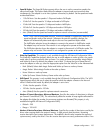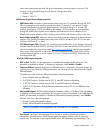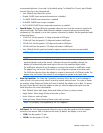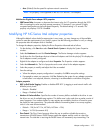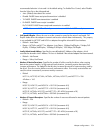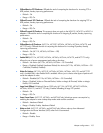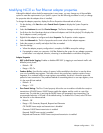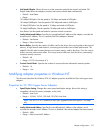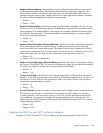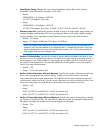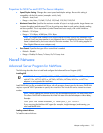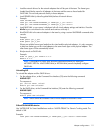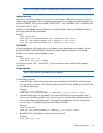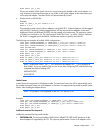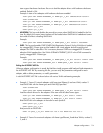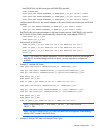Adapter configurations 108
• Adaptive Interframe Spacing. Compensates for excessive Ethernet packet collisions on the network.
The default setting works best for most computers and networks by dynamically adapting to the
network traffic conditions. However, in some rare cases, you may obtain better performance by
manually setting the spacing value. Setting a value forces a static gap between packets. Increasing
the value increases the delay between frames being transmitted.
o Default = 1
o Range = 1–255
• Number of Coalesce Buffers. Specifies the number of memory buffers available to the driver in case
the driver runs out of available map registers. This buffer area is also used when a packet consists of
many fragments. If no coalesce buffers or map registers are available, the driver is forced to queue
the packet for later transmission. The preferred method of transmitting data is to use map registers,
since it is the most efficient method.
o Default = 8
o Range = 1–32
• Number of Receive Descriptors: Minimum/Maximum. Specifies the number of descriptors used by the
driver when copying data to the protocol memory. In high network load situations, increasing
receive descriptors can increase performance. The tradeoff is that this also increases the amount of
system memory used by the driver. If too few receive descriptors are used, performance suffers. If too
many receive descriptors are used, the driver unnecessarily consumes memory resources.
o Default = 32
o Range = 8–1024 (in increments of 8)
• Number of Transmit Descriptors: Minimum/Maximum. Specifies the number of descriptors to allocate
per Transmit Control Block (TCB). This value directly affects the number of map registers allocated for
the adapter (the higher the number, the more map registers are allocated).
o Default = 12
o Range = 1–16
• Transmit Control Blocks. Specifies how many Transmit Control Blocks (TCBs) the driver allocates for
adapter use. This directly corresponds to the number of outstanding packets the driver can have in its
send queue. If too few TCBs are used, performance suffers. If too many TCBs are used, the driver
unnecessarily consumes memory resources.
o Default = 16
o Range = 1–80
• Transmit Threshold. Specifies the number of bytes before the PCI adapter empties its internal transmit
FIFO onto the wire. The value is multiplied by 8 to produce the number of bytes. For example, if
Transmit Threshold = 200, the number of bytes is 1600. This is greater than the maximum packet
size for Ethernet. Consequently, the adapter will not attempt early transmits. Although this is the
safest setting, the best performance is achieved when the Threshold parameter is as low as possible
without producing underruns.
o Default = 200
o Range = 0–200
Properties for NC61xx and NC71xx Server Adapters
Exception: HP NC6170 and NC7170 Server Adapters are not supported under Windows NT® 4.



